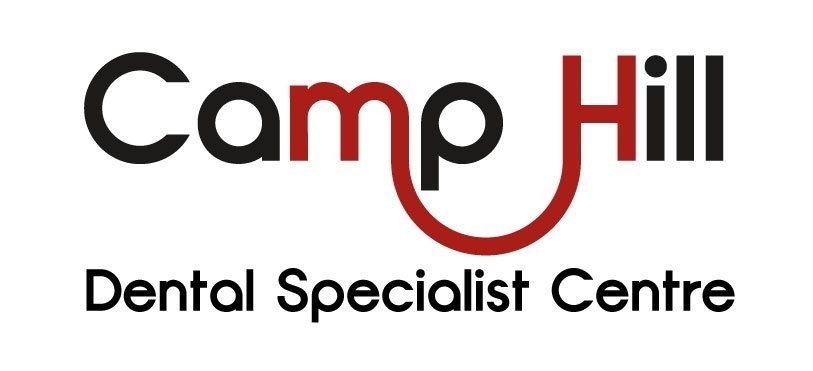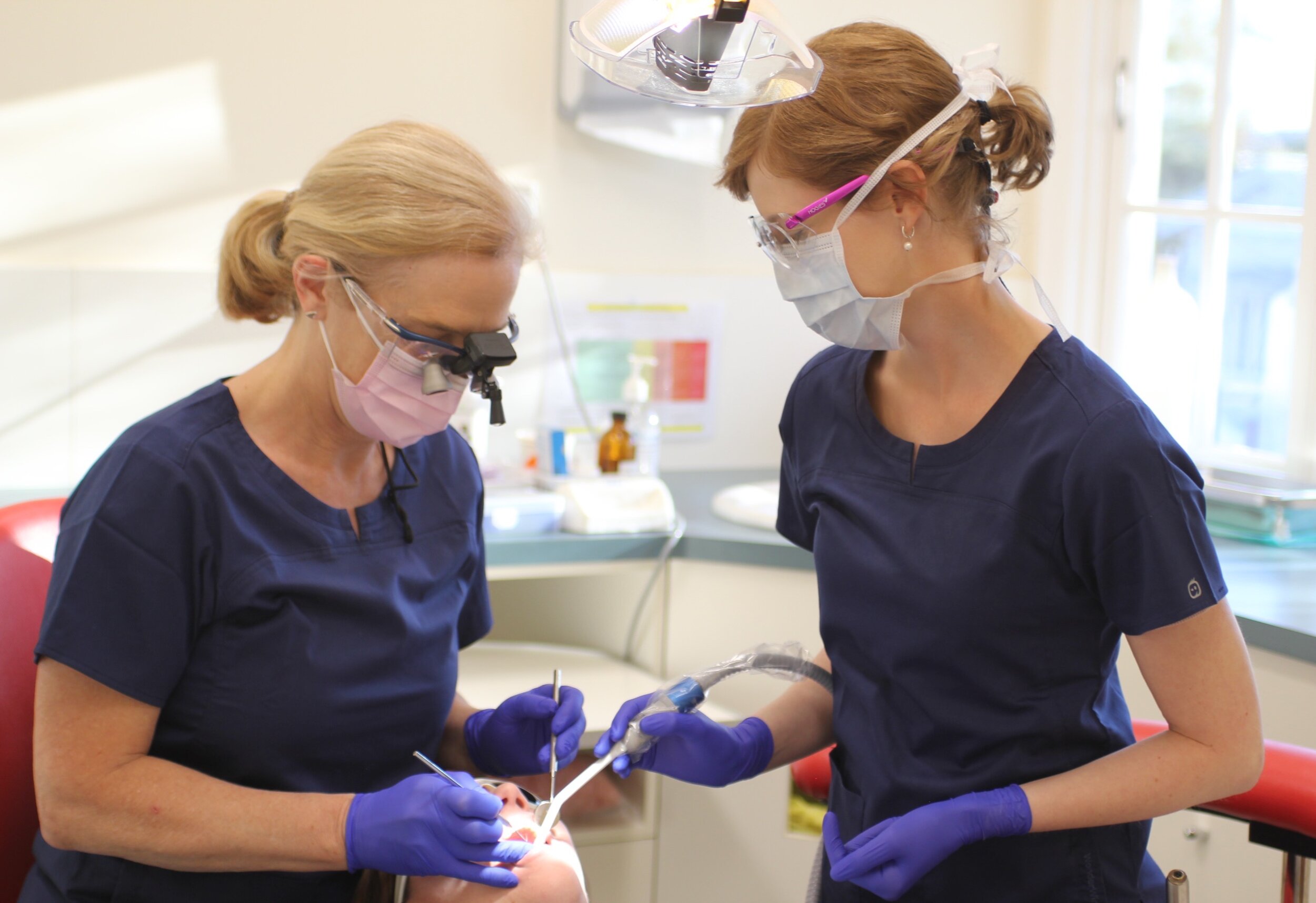Periodontics: This involves treatment of any condition associated with the gums. The most common reason for referral is for management of periodontitis or gum disease. Periodontics is all about the health of your mouth and hygienists are utilized to assist the periodontist in looking after your mouth.
Our periodontists see patients to manage problems associated with the gums and the bone support around the teeth. At Camp Hill Dental Specialist Centre, we provide periodontal services including:
Treatment of periodontal diseases
Gingival grafting to treat areas of receded gums
Repositioning or reshaping of gum margins
Other minor surgical procedures such as frenectomy
At your consultation appointment, care will be taken to ensure your treatment is fully explained and that you are able ask questions and understand the procedures involved.
Treatment of periodontal disease
The primary reason for seeing a periodontist is for treatment of gum disease or periodontitis. This disease is generally a painless infection of the gums which can in severe cases lead to the loss of teeth. The disease is caused by a build up of plaque and calculus deposits (scale or tartar) on the teeth and their roots. Plaque is a film of bacteria which forms at the gum line every day. If this is not able to be brushed away, it can develop into mineralized deposits called calculus. All these deposits will then cause inflammation and destruction of the gums. A number of factors will influence how much damage is caused by plaque. These can include smoking, Diabetes and genetic factors.
The common signs and symptoms of gum disease include:
Bleeding gums
Sensitive teeth
Gaps developing between your teeth
Loose teeth
Getting ‘long in the tooth’
Bad breath
Management of periodontal disease is an ongoing effort from both the patient and the dental practitioners. Assistance is given to you to ensure you are well informed regarding your role in looking after your dental health on a daily basis. It is common for us to develop long term relationships with our patients and regular visits to our practice to see either Susan or the dental hygienists will be advised as appropriate.
Gingival grafting
Gingival grafting is a procedure where gum from one area of your mouth is grafted to an area where there is a deficiency of gum. Recession of gums can make it difficult to keep the tooth clean and this is a primary reason for treating recession with a gum graft. Recession on a front tooth can also be an aesthetic problem and can be improved by a graft.
Crown lengthening
Gums can be repositioned or ‘lifted’. This is often done for cosmetic reasons if the front teeth are short or too much gum shows when smiling. This is generally undertaken in conjunction with your dentist who plans your overall cosmetic treatment. The gum can also be repositioned when a tooth is very badly damaged and there is insufficient tooth structure for you dentist to restore the tooth. Once more tooth is exposed above the gum margin, the dentist can place a crown on the tooth.
ALL ABOUT PERIODONTAL DISEASE
Periodontal disease is usually a slowly progressing disease which most people are unaware they have as they have not noticed any changes in their mouth or experienced pain. Signs of periodontal disease include bleeding gums, bad breath, a bad taste, loose teeth, change in tooth position and receding gums. Periodontal disease is caused by plaque which is a sticky film of bacteria which builds up on teeth, particularly at the gum line. The by-products of these bacteria cause inflammation.
There are two forms of periodontal disease:
Gingivitis - inflammation of the gums caused by plaque not being effectively removed every day. The gums will look puffy and red and bleed easily if touched by a toothbrush. Gingivitis is reversible and does not cause permanent damage to the tissues. Your teeth need to be cleaned and correct home care undertaken. In some people untreated gingivitis may lead on to the more serious condition known as periodontitis.
Periodontitis –bacterial products eventually result in breakdown and permanent loss of the gum tissue and underlying bone which are the supporting structures of the teeth. In periodontitis the close connection between the gum and the root surface is lost as the tissue is destroyed. This allows formation of a pocket or a gap between the tooth root and gum into which bacteria can accumulate and cannot be removed with toothbrushing. These bacteria then mineralise and form hard deposits on the root surface called calculus (also known as tartar and scale). The bacterial toxins and by-products of inflammation then cause further destruction of the gum tissue and the bone around the roots. The signs of periodontitis are detected using a periodontal probe which measures the depth of the pocket and the degree of inflammation. Radiographs are required to show the amount of bone destruction.
Who gets periodontal disease?
Not everyone is susceptible to destructive periodontal disease and evidence suggests your resistance or susceptibility to the disease may be inherited from your parents. Periodontitis can run in families.
There are certain factors which can make you more susceptible to the disease. Smoking in particular reduces your resistance to periodontitis and smokers generally show more periodontal destruction than non smokers and do not respond to treatment as well. This is a result of both local effects in the mouth of the toxic products of cigarettes as well as a general depression of the immune system which is very important in protecting against periodontal disease. Medical conditions such as Diabetes can also result in more severe and rapid tissue destruction. Hormone changes in pregnancy result in the body having an exaggerated response to plaque causing an increased gingivitis or in those people who are susceptible to periodontitis, an increase in tissue destruction.
What does periodontal treatment involve?
Periodontal treatment aims at preventing the ongoing destruction of tissue and maintaining your teeth in a stable, healthy state. This is achieved by reducing the levels of bacteria around your teeth by your daily removal of plaque as well as by professional removal of calculus and bacteria below the gum line. The effort you make every day with home care is the key factor in success of periodontal treatment. Consequently time is spent in showing you the correct way to brush and clean between the teeth and finding suitable aids to make the job easier.
Professional removal of plaque and calculus deposits may be undertaken over a number of visits and depending on your disease severity and your needs, local anaesthetic can be used to eliminate discomfort. Debridement (also known as scaling and root planning) is the term used to describe the meticulous removal of all the bacterial deposits on your teeth leaving a clean smooth root surface. Some dental fillings are positioned at or beneath the gum line and result in a rough surface that makes flossing difficult and will also accumulate plaque. Consequently time is spent polishing fillings and making your teeth easier to clean. Occasionally despite good plaque control, the gums do not respond to this type of treatment and adjunctive antibiotic therapy is indicated or in some instances periodontal surgery is needed which enables better access to cleaning difficult root surfaces. The response to treatment and the degree of healing obtained does vary between individuals.
As periodontitis is a disease which is controlled rather than cured, ongoing therapy is needed and is very important in preventing recurrence of the disease. This is called maintenance or supportive periodontal therapy and it aims to monitor and control your disease. It consists of regular visits at 3 to 12 monthly intervals at which time your oral hygiene is assessed, the health of the gums checked and any plaque or calculus that has formed around the gum line is removed. The hygienists at our practice are involved in these regular recall visits and undertake most of this care with the periodontist making an assessment of your progress. These visits to our practice are often alternated with your referring dentist who needs to maintain a regular check on other aspects of your dental health.
What are the side effects of treatment?
Following debridement there will be some tenderness of the gums. In most cases this is not severe and mild analgesics can be taken for the first day to reduce any discomfort. It is important to maintain good plaque control despite some discomfort during this important healing phase.
Tooth sensitivity is a common problem following treatment and you may notice pain on eating hot, cold or sweet food and drinks. This decreases with time, however some people do have ongoing problems and various toothpastes and professionally applied solutions are used to ease the problem.
The gums commonly shrink or recede as they heal and the inflammation resolves. Depending on the severity of the initial swelling this can result in looking a bit longer in the tooth or noticing small spaces between your teeth at the gum level.
What are the benefits of periodontal therapy?
Periodontal treatment aims to provide you with a better chance of keeping your teeth for a lifetime and avoiding wearing dentures. In the short term you will notice that your mouth feels and looks healthier, swollen red gums will become firm and pink and the bad tastes and breath associated with the periodontitis will improve.
There is also evidence that healthier gums are better for your general health, for example Diabetic control can improve with periodontal treatment.
Periodontal care is an important part of your overall dental care. By preserving the ‘foundations’ of your teeth, it provides the healthy basis for all other dental care.
YOUR QUESTIONS ARE ALWAYS WELCOME


